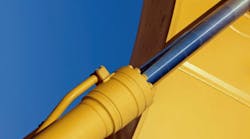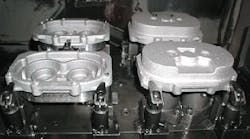Whether for machining bulky workpieces, or in projects that require precision finishing in a production process or machining center, hydraulic vises and similar workholding systems offer a highly flexible and stable fixturing solution that speeds up work cycles and cuts down on waste.
In many situations, a machine shop simply cannot afford to apply traditional mechanical vises and other clamping devices to hold workpieces in place. Examples include tasks involving heavy and/or oversized workpieces that are difficult to mount manually, and to apply the necessary clamping pressure evenly and consistently, thereby risking movement or vibrations that result in scrap.
“In the past, one machine shop was having some difficulties machining welded beams that were perfectly straight – using a mechanical vise setup,” said Larry Johnson, president of Special Machined Components, a shop in Mason, Ohio. “Due to the size of the workpieces, mechanical vises were tough to load and control. I understand that they had to scrap quite a few of the beams during the first two or three months of production, perhaps 50 of them.
“However, at our shop, thanks to our hydraulic workholding system, I don’t think we’ve had to scrap 10 workpieces over a 12-year period, certainly a huge improvement over the mechanical vises.”
Special Machined Components began machining beams for heavy-duty vertical lifting systems in 2001. The lifting systems — which normally use four or six of these beams — are used to raise heavy vehicles like trucks, buses, and fire trucks overhead, for maintenance. Naturally, consistently precise machine finishing was required for every beam, each one of which needed to support from approximately 15,000 to 40,000 lbs., providing a total lifting capacity of 160,000 lbs.
The hydraulic workholding system that Johnson’s company installed in 2001 was a six-vise, stacked ProHold model manufactured by Planet Products. Some job shops use it for welding and riveting as well as machining operations.
One of the problems of using a mechanical vise for large or heavy workpieces, such as those that are machined by Special Machined Components, is that it is difficult to set up the machine for consistent clamping. For example, if a powerful, 225-lb. operator is working the first shift is followed on the second shift by a much smaller man, there is likely to be a difference in the clamping power between the two shifts.
Also, over-clamping, or clamping a vise too hard, can create workpiece distortions, which results in wasted material and production time.
Consistency in Production
Shops using hydraulic vises often are applying them to production runs, where the consistency of clamping grip and ease and quickness of operation are most important. The operator simply sets the holding pressure, and the device holds each production workpiece the same way.
“Our hydraulic vises have a pre-set, c mechanism,” said Larry Johnson. “You just open or close the valve on it and the jaws open and close. Because we’ve got six vises on our system, we have one valve for controlling the front three vises, and another valve to control the back three vises. You just have to flip a valve and that opens and closes it. It’s really easy to operate.”
The powered opening allows a 400 lb part to rest on the vise and is always open. This typically would not happen with a spring return vise.
Johnson said the mechanical workpiece vise would be much more difficult to operate adequately for his application.
“Doing this kind of work would be a really tough job if you were using mechanical workholding fixtures,” he explained. “Each one of these beams we are machining weighs about 400 lbs. To use a mechanical vise you’d have to use a hammer to go around and make sure they’re tight enough.
“With the hydraulic vises, we’ve got much better control, and no concerns about operator errors,” he continued. “Using the ProHold hydraulic I’ve never had a problem with workpieces coming lose. The hydraulic system is the only way to do it. It’s more expensive, but pays for itself.”
ProHold is among the better established brands of hydraulic workholding systems, and was acquired by Planet Products in recent years. Planet, known best for its live tools and “speedier” tool heads, purchased ProHold because the line accommodates individual setups, machining centers, and automated centers, and also because ProHold workholding systems offer some distinct features.
For example, the vises have a longer hydraulic stroke, which can facilitate quicker loading plus ability to clamp wide range of parts with same tooling. The long hydraulic stroke allows parts of several different sizes to be processed with the same top jaws, significantly reducing set ups time and effort.
“That definitely makes a difference in our application,” said Johnson. “Our workpieces — the beams — weigh about 400 lbs., and the vises open up wide enough that you can load them quickly and easily.”
He added that automatically closing the vises simultaneously saves time and efforts. Each set of jaws moves independently and can clamp different-sized parts at the same time with uniform clamping pressure.
The hydraulic vises that I have will accommodate all three different sizes of the beams we machine,” Johnson said. “So, if you are running the same types of parts like we are, the hydraulic vises are an easy setup. It’s just a matter of changing the jaws on them and you’re ready to go again.”
Also, the full hydraulic control allows synchronized operation of multiple vise and even automated or remote control, eliminating operator variation and ergonomic issues.








